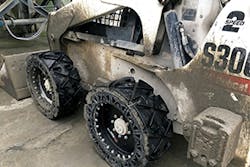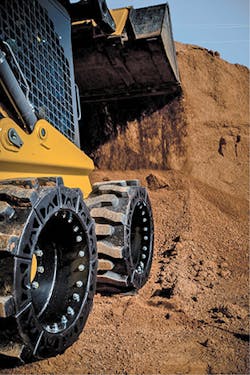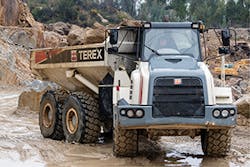Tires are wonderful things. They solved transportation and mobility issues for a lot of people throughout history, from wheel-mounted siege weapons to horse-drawn carriages to wheelchairs to cars to construction equipment. However, throughout history, people have been dealing with the shortcomings of tire technology.
Wheeled machines can’t traverse rough, rocky, or muddy terrain as well as tracks, and wheeled machines are more likely to get stuck in mud or snow and need to be pulled out by a tracked machine. Wheeled machines are less stable than tracked machines and are also less maneuverable since tracked machines can rotate within their own footprint by advancing one track while reversing the other.
To find a solution that can offer similar transportation and mobility benefits as tires, people invented tracks—railroad tracks. Railroad tracks allowed for easy movement across surfaces that are difficult for tires to traverse and could provide even greater speeds. However, railroad tracks are a big infrastructure investment and it severely limits travel flexibility; you can travel from Point A to Point B and not much else.
To overcome the limitations of railroad tracks, a Polish mathematician named Richard Lovell Edgeworth designed a crude continuous track system in the 1770s. The design wasn’t realized until 60 years later. In 1858, English agricultural engineer John Fowler filed a patent for a form of “endless railway”; it’s a precursor to the multi-section caterpillar track. A caterpillar track features a relatively large number of short transverse treads (versus long longitudinal treads). In 1877, a Russian inventor, Fyodor Blinov, created a tracked vehicle called “wagon moved on endless rails.” His track technology was employed in the Russian Army, and the soldiers began referring to the machines as “caterpillars.”
Although there is a connection between the company Caterpillar Inc. and caterpillar tracks, the tracks didn’t get the name from the company. In the early 20th century, The Holt Manufacturing Company adopted the “Caterpillar” name for the company’s crawler tractors. In 1908, the company released the Holt Model 40 Caterpillar crawler tractor. Two years later, the company trademarked the name “Caterpillar” for their continuous tracks. Nearly two decades later, the company merged with C. L. Best Tractor Company to become Caterpillar Tractor Company (Caterpillar Inc.).
Modern tracks use modular chain links in chain formation that are jointed by a hinge; the chain wraps around a set of wheels.
Now, tracks and tires are options on a number of types of equipment. Which option is best for your application? The answer might be obvious but, in some cases, there are a lot of nuances to consider.
Evolution Wheel’s EWRS-AT solid tires
Tires vs. Tracks
“Tires on graders, loaders, dozers, and excavators have to be some of the toughest-built tires on the market, able to work in a wide range of conditions—rock, mud, sand, gravel, and debris—and they also require excellent traction,” says Seth Walters, vice president, aftermarket sales (East), Alliance Tire Americas. “Traction is especially important if they’re on a dozer or grader, where it’s all about getting traction to minimize spin and maximize productivity. On a loader or excavator, you’ve also got shifting loads that can vary dramatically, which constantly changes the amount of force applied to the tire and where that force is concentrated.”
One of the best ways to fairly compare the two undercarriage options is to compare two nearly identical machines—one with tires and one with tracks, such as the skid-steer loader and the compact track loader. Kevin Coleman, SSL product expert at Caterpillar, describes some of the benefits of each system, as well as some applications in which there is little difference to operations.
“Track loaders are suited for most any application,” says Coleman. “The advantages that they provide are increased flotation/decreased ground pressure—whichever way you want to look at that, greater traction, they cause less damage to the terrain, and have higher capacities. A like-sized track machine will have a higher tipping capacity than a like-sized wheeled machine. Tracked machines offer a different platform, which generally allows for higher rated operating capacities (ROC).
Also, with tracked machines, you can work more days. You can begin work earlier and end work later in the construction season, and you can work days when the job site is wet from rain, and the skid-steer can’t perform or may leave ruts in the terrain that require additional rework to fix.
“Track machines have a large footprint that contacts the ground and allows them to push very well. For that reason, they also tend to perform better on slopes,” continues Coleman. “On Cat machines, the suspended undercarriage moves independent of the chassis, thereby keeping even more track on the ground than a rigid frame undercarriage. Its ability to float independently on either side means the machines tend to perform better on uneven surfaces.”
“Most operations, from small construction projects to the world’s largest surface mines, benefit from a mix of wheeled and tracked equipment,” says Rob Seibert, director of marketing, off-the-road tires, Bridgestone Americas. “In general, wheeled equipment provides the greatest flexibility, speed, and mobility whereas tracked equipment provides a more stationary platform for digging operations with more options for below grade. Tires excel in a variety of conditions but clearly grader, loader, and material handling applications benefit from mobility tires while dedicated excavation benefits from a tracked platform.”
“Tires can be an outstanding alternative to tracks,” says Walters. “They’re pretty much a must-have for machinery that travels on pavement, whether it’s down the road, on a housing or commercial development job site, or even around your equipment yard. Steel tracks can be murder on pavement, and on the flip side, pavement can be murder on rubber tracks. Properly inflated tires, assuming they are large enough for the machine, can deliver very comparable traction and flotation to what tracks do.”
“Wheeled machine advantages include increased speed, especially on harder surfaces,” says Coleman. “Wheeled machines work better on a flatter or even surface, such as you find in paving and material handling applications. A flatter surface allows for the increased speed of which the skid-steer loader is capable. They’re also lighter, which can aid in transportability if you’re considering trailer weight. Also, in general, a wheeled machine will be less expensive to purchase and maintain.”
“The initial purchase cost of tires is lower, and tracks require more undercarriage maintenance, which adds to their cost,” says Walters. “Tires are also easier and less expensive than tracks to change out or repair. And properly inflated tires can deliver very comparable traction and flotation to tracks.”
Tracks feature much greater mechanical complexity, and compact track loader undercarriages tend to require more attention to maintenance to maximize component life versus their wheeled counterparts. If not maintained and operated correctly, the tracks can also ride off their guide wheels, idlers, or sprockets, which can cause them to jam or to come completely off the guide system.
“Tires also have the advantage in snow or deep mud, where they are more effective than tracks at digging in for traction,” says Walters. “And while tracks are pretty straightforward in terms of design, tires offer a wide range of choices for different needs, whether we’re talking about tread pattern, ply rating, or price point.”
Under a few conditions, it doesn’t matter whether you used a wheeled machine. If you’re operating on solid, flat ground, and you don’t need to lift heavy loads or really dig in to push or travel fast or far, if trailer weight isn’t an issue and your job site is under these same conditions every day, then it probably doesn’t matter which machine you use. However, most people will have to look at the specific nuances of what they expect the machine to do and what they expect their job sites to look like and then pick the platform that best suits those needs.
Tires vs. Tires
“It’s important to understand the application and job site conditions well before choosing a tire for an equipment,” says Seibert. “At Bridgestone, we recommend customers work with their dealers to determine the right tire for the right application. Dealers understand the equipment and operational condition of the equipment, and offer proper tire maintenance services to ensure maximum uptime and productivity.”
When choosing a tire for your application, “First consider the ply rating—how thick and tough the tire carcass is. Obviously, with heavy equipment, especially in tough conditions, the overall rule is, more is better,” says Walters. “The next thing to look for is the tread design. An excavator that’s going to be wallowing around in mud is going to need an aggressive tread design—lugs, bars, or blocks that really claw into the soil to provide traction. A tire that is going to be used primarily on compacted or paved surfaces should have massive blocks with a high rubber-to-void ratio to reduce abrasion wear and improve stability. Grader tires are somewhere in the middle—they’re generally working on relatively compacted, dry surfaces, so they tend to have a bar or S-shaped tread with enough traction and self-cleaning to function in dirt and gravel, but that are blocky and dense enough for a smooth ride and wear resistance.”
Traction is essential in changing conditions.
Self-cleaning is very important in off-road applications. “You’re going to want to make sure the tread is designed to clear out mud and rocks as the wheel turns so the lugs are ready for another bite,” says Walters. “Look for a pattern that seems to channel mud and dirt out to the sides of the tire and open up at the shoulder to eject it. On high-quality tires, you will also see little protrusions between the lugs that we call ‘mud breakers’ which help crack built-up soil deposits as the tire flexes, which allows the tire to spit the dirt out.”
“In the grading and excavation market, we’re seeing growing interest in radial tires,” says Walters. “I think we’re getting close to a tipping point where radial tires will overtake bias-ply ones in the excavation and grading industry, mostly because they provide a lower total cost of ownership. It costs a bit more to buy a set of radials, but those tires will typically last longer, perform better, and reduce operating costs more than bias-ply tires will.”
The key is in how radials work. “Radial tires have more flexible sidewalls than bias-ply tires do. That—plus a stiff radial belt behind the tread—allows the tire to put more of its tread in contact with the ground, creating a larger, more evenly distributed footprint,” says Walters. “The large footprint provides better traction and flotation, and it’s more effective at transmitting horsepower from the machine to the ground. Also, look for all-steel construction when purchasing radial tires.”
“Radials are designed for long distance, such as long-haul trucking, ADTs, and rigid frame trucks, as well as loaders that travel further distances,” says Johni Francis, global OTR product specialist, Titan International. “Bias tires are designed for shorter distances and providing greater stability.”
“Research in tractor tires demonstrated improvements in fuel efficiency of as much as 16% when switching from bias-ply to radial tires. That adds up quickly,” says Walters. “A large, even footprint also helps the tread last longer, because it wears more evenly. And we construct our radial sidewalls with a special belt design that reduces stress at the belt edges, slowing wear and reducing heat buildup.”
“In 2017, Bridgestone introduced 14 new Firestone VersaBuilt radial tires to support our dealers and customers with an even larger construction tire offering,” says Seibert. “Firestone VersaBuilt radial tires provide solid traction and durability for loaders, graders, and earthmovers, ensuring maximum performance in a variety of conditions, ranging from muddy to rocky surfaces. These tires are built with steel casings and SideArmor sidewalls that protect against cuts and punctures by deflecting stones and debris to help customers get more wear life from each tire. We are looking to enhance our offering in this line to deliver a complete portfolio of dependable, durable tires that will get the job done in a variety of construction environments.”
To support various applications, Bridgestone offers 60 tread patterns in both radial and bias construction. “Another of our latest offering is Bridgestone 59/80R63 VRF tire with Cooling Fin technology specifically designed for users in severe haulage applications with high payloads, speeds, and bead heat,” says Seibert. The innovative Cooling Fin technology from Bridgestone generates air flow around the tire, cooling the tire and reducing heat generation to improve tire life and productivity. In Off-the-Road (OTR) applications, Bridgestone’s innovative Cooling Fin technology has been shown to increase tire life by up to 10% and reduce bead temperature by approximately 20%.
“To compete with the flotation and traction provided by tracks, Titan offers a wider-base tire size—a 750/65R25 size—in their STL3 radial line. “Right now, we’re just offering the 65-series aspect ratio tires in our most popular E-3/L-3 radials, but we’re looking at expanding that into some of our other popular lines,” says Francis.
“No matter what kind of equipment you’re running, you need to minimize downtime, which means that a tire has to be puncture-resistant and have a tough bead to stay firmly on the rim,” says Walters. “In rocky conditions or areas with debris like demo sites, punctures are of particular concern, along with chipping or chunking of the tread. We build our Galaxy off-the-road (OTR) tires with special consideration for puncture protection—extra durable plies in bias-ply tires and special radial and sidewall belts in our radials—and formulate extremely durable tread compounds to resist puncture, chunking, and wear. And, of course, where the hazards are extreme, it may be worthwhile to try foam-filled bias-ply tires or switch to solid tires.”
Gravel can be a challenge because stones can get lodged in the tread, where they can eventually pierce the tire, or between the bead and rim, causing a blowout. In addition to improving the compounds in their tires and beefing up their under-tread package, ATG engineers have designed treads specifically to eject gravel and to protect the bead area with rugged bead construction and special, molded guards to minimize the risk of bead failure.
“The ability of a tire to clean its tread as it rolls is critical to maintaining traction in muddy conditions,” says Walters. “A tread packed with mud is like a racing slick. We work hard to ensure that our traction treads have features like mud breakers, stepped lugs, and open channels on the shoulders that promote good self-cleaning.”
Rubbertrax sells a line of flat-proof tires. “Downtime is reduced by several factors because they last five times longer than tracks or pneumatic tires. They are maintenance-free, no air pressure to check and no need to check for debris. There are no blowouts and since flats are eliminated, there is no more waiting on flat repair and inconvenient tire changes,” says Nancy Jones, account manager, Rubbertrax.
While selecting the right tire is the first step, proper tire care and maintenance are fundamental to tire performance, particularly in an off-the-road setting. Tires are a large expenditure for construction fleets, and properly maintaining tires is critical to getting the most out of a fleet’s tire investment. Over time, tire performance directly impacts productivity and that translates into a business’s bottom-line.
“We are seeing that off-the-road customers are expecting more support from manufacturers beyond just tires. They need technologies and solutions which will help in optimizing production, reducing costs, increasing efficiency, and improving safety on job sites. Dealers should work with the manufacturers to provide service solutions to maximize productivity and lower total cost of ownership.”
Bridgestone recently launched PressureStat, a solution-driven technology designed for off-the-road tires, which provides instant access to important tire data, helping owners and operators better manage their inventory and extend the lifecycles of their tires.
PressureStat, combined with TreadStat, the Bridgestone tire, and rim management tool, transmits tire pressure data via Bluetooth to any mobile device with the TreadStat app, which allows users to monitor, inspect, track, and report through the platform.
Tracks vs. Tracks
Track options are ever increasing. Caterpillar offers two track options for their compact track loaders and multi-terrain loaders.
“Narrow tracks give machines more grip and wider gives them more flotation,” says Jones. “There are many tread patterns to choose from when selecting a track for your machine. For example, some customers may need more traction because they are working in mud or hillsides; others may need a heavy-duty thicker track because of the work with debris or concrete. We have all applications covered from snow, mud, rock, finished landscape, or debris-filled areas.”
Rubber tracks have been around for more than a century, and are popular in agricultural, paving, and sensitive terrains. “Rubber tracks are great for all terrain types and are very popular for terrain that requires extra flotation or when it’s necessary for the turf not to be disturbed—for example, manicured lawns,” says Jones.
“The main thing that needs to be highlighted is that there are so many different tracks options available with different guide systems,” continues Jones. “Some of the rollers ride on the outside of the guide, some of the rollers ride on the top of the links, some ride on the inside of the links. There are different widths, inside guides, and outside guides for tracks. There are single flange, double flange, and triple flange rollers to sit in the guide, on the guide, and outside the guide. The most important thing is to get the customer the correct track for their machine. Due to the three different measurements for a track, there are tons of different sizes for all the machines out there. Some machines can run with different widths as well. It’s up to the operator to choose wisely depending upon the application of the machine.”
Says Jones, “Continuous steel cords [CSC] are different from other tracks in that other tracks overlap the steel cords at a single joint. CSC technology provides up to 40% more strength in the track. Given proper use of the machine, this can potentially extend the lifespan of your tracks and save your company considerable money over the years in replacement tracks alone. All of our tracks have the CSC with the exception of the NMC [nonmetal core tracks usually used on ASV, Terex, VTS, Versatile Track System, or Loegering machines].”
Earlier this year, Camso, formerly Camoplast Solideal, unveiled its new smart track technology in North America. The new smart track technology is designed to help farmers protect their investment while improving the track’s durability.
“As the leader in track development, we’re committed to redefining the industry standard and engineering products that respond to the evolution of farming equipment. The market is heading toward more specialized applications, toward larger, heavier, and faster machines, and toward greater productivity,” explains Martin Lunkenbein, service and aftermarket sales executive director—agriculture at Camso. “We offer the broadest range of tracks in the industry and keep expanding our range to meet the needs of the market. New technology releases such as smart tracks demonstrate our commitment to developing solutions that advance a farmer’s operation in terms of efficiency and productivity,” he says.
The technology employs a temperature sensor embedded in the track. If the track reaches high-temperature levels, the sensor sends a signal to the tractor, ensuring that speed is readily adjusted to protect the track investment.
Camso’s smart track technology is designed for high-speed roading. “With higher roading speeds and fields farther away from each other, farmers are looking to operate at maximum transport efficiency. Our integrated solution allows for optimal machine speed while avoiding heat buildup, which can cause premature track damage,” says Lunkenbein. Camso already offers the leading roading track solution, using the best compounds and ensuring optimized tread life.
ConclusionNo undercarriage platform is superior to the other, but one will often work more optimally than the other on some terrains and in some applications. Tires work better when speed is a premium and the surface is hard. Tracks work better when stability is a premium and the surface is soft or wet. Consider the applications and terrains that you expect, and then select the platform that meets your needs and works best most of the time. For further questions, all tire and track manufacturers recommend that you speak to your dealer.












